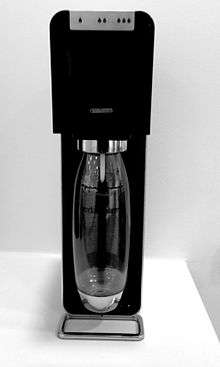Soda machine (home appliance)
A soda machine or soda maker is a home appliance for carbonating tap water by using carbon dioxide from a pressurized cartridge. The machine is often delivered with flavorings which can be added afterwards to the carbonated water to make soda, like for instance orange, lemon or cola flavours.

Examples of well known soda machine manufacturers are SodaStream of Israel, and Aqvia by AGA of Sweden.[1]
Soda machines can either be connected to a separate water tap in the house, or be a freestanding unit. Some refrigerators are delivered with a built-in soda machine.
Construction
Soda machines normally use disposable gas cartridges, which are normally filled with around 300–500 grams of carbon dioxiode. The water to be carbonated is filled in special pressure resistant bottles which are attached to the machine in a pressure proof way. The gas is then added to the water via a pipe and valve system which is activated by pushing a button. The resulting amount of carbon dioxide is determined by the pressure in the CO2 cartridge and how long the button is held down. If the pressure is too large, residual pressure is relieved through a blowoff valve.
Advantages
Depending on the size of the gas cartridge, a soda machine can produce up to 100 liters of carbonated water before the cartridge needs to be replaced. Compared to buying carbonated water in the store, this eliminates packaging and transportation costs, and also results in less waste and possible less use of storage space. Gas cartridges and compatible water bottles can be purchased in many super markets. The pressure resistant bottles can also be used to store the carbonated water. Some newer machines can also be used with glass bottles. Some newer PEN-bottles can also be machine washed.
Flavoring
Makers of soda machines also offers a selection of flavors which can be added after the water has been carbonated. Some of these are sugar free. Alternatively, normal squash can be used.
Health risks
Teeth
Carbonated water has a low pH-value, and overuse of carbonated water can therefore lead to acid erosion of the teeth, similarly to consuming other sour beverages and food (like soda or fruits). Drinking straws can be used to prevent acid erosion by minimizing direct contact between the sour drink and the teeth.[2]
Bacteria
In a study by the Institute of Hygiene and Environmental Medicin at the University of Mainz, (Germany), ble coliform bacteria were found in 39% of the tests when water was carbonated in soda machines, compared to 12% in the tests of water straight from the water tap. In addition to the said pollution contaminants from the gas cartridge or the machine, the microbiological quality of the water was also affected by a biofilm at the inside of the bottles.[3]
In addition to poor cleaning compared to the manufacturer instructions, poor design of the soda machines was also given as a possible cause to the increased amount of bacteria.[4]
It is recommended to regularly perform simple cleaning routines according to the manufacturer instructions. This includes cleaning the bottles with hot water (above 50 °C), using soap and a clean cleaning brush.[5]
Gallery
 A Sodastream machine from 1999, opened from the rear showing the CO2 cartridge
A Sodastream machine from 1999, opened from the rear showing the CO2 cartridge
See also
- Soda syphon
- Soda fountain
References
- Test: Aqvia vs SodaStream – DinSide
- Bruk sugerør hvis du vil spare tennene | ABC Nyheter
- Wolfgang Kohnen et al.: Microbiological quality of carbonated drinking water produced with in-home carbonation systems, In: International Journal of Hygiene and Environmental Health, Band 208, 2005: S. 415–423, doi:10.1016/j.ijheh.2005.04.008.
- Lebensbedrohliche Infektionen durch Keime, die häufig in Haushaltsgeräten zur Herstellung von Sodawasser (z. B. Soda-Club, Wasser-Maxx, Soda-Maxx) gefunden wurden. Pressemitteilung. In: uni-freiburg.de. Albert-Ludwigs-Universität Freiburg K. d. Ö. R., 17. Mai 2006, aufgerufen und empfangen am 14. Juni 2016 (deutsch; Mitteilung über eine Untersuchung von Geräten).
- Soda-Club GmbH: Kohlensäure hält Trinkwasser frisch und rein (PDF; 21 kB), Pressemitteilung, 4. September 2006